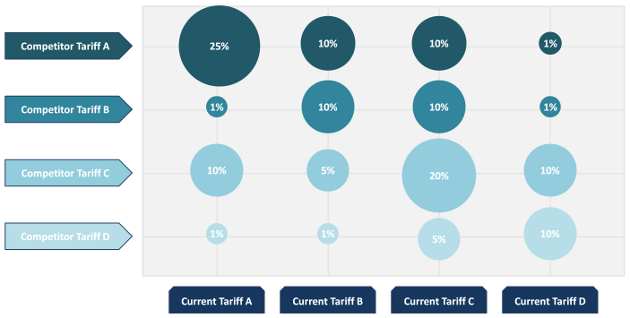Perfect Portfolio Design
Introduction
Every second telecommunications CEO is aware of new market entrants. This leads to stronger competition in saturated markets such as Western Europe. For example, telecoms from emerging markets are looking for profitable assets abroad, utilizing their well built low-cost operating models to oust local incumbents. There is also the fact that companies new to the industry will enter the market with own competitive products. More than 70 percent of telecom managers are awaiting such engagements within the next two years.
Modern Tariff Management

Against this background, telecom companies urgently need to identify future growth opportunities to stay competitive. Clintview ensures this approach by incorporating customer behavioral analysis to product price plan design. This allows telecom companies to accurately determine which of their competitor’s products will and will not affect their own portfolio. More importantly, Clintview precisely measures the financial impact caused by alterations to price plans.
Customer Centered Services

In order to increase tariff management efficiency, Clintview enables companies to investigate customer segments. The aim is to perfectly fit new products to each customer’s needs. Furthermore, product, billing and finance managers are able to forecast and individually offer new products, packages and tariffs across multiple converging platforms. This enables Telco’s to stay informed about each customer’s lifecycle.

The above graph shows the threat caused by the tariff range of a competitor to the actual portfolio. Whereby, a competitive threat is defined as a saving potential of certain percentage compared to the price a customer pays in his actual tariff. For example: 25% of customers subscribed to tariff A would be better off shifting to tariff A of the simulated competitor.
Modular Data Model

Clintview is designed as an engineering software for products and customers. It delivers a universal data model enabling telecom companies to portray any given portfolio regardless of their origin.
The concept behind Clintview is to decompose a product to its single components. For example: Assume a typical telecommunication price plan offering a tariff with a minimum call charge of 20 EUR. This charge can be used both for calls within a specified telecom network including mailbox and calls to fixed line networks. Now this specification needs to be translated to Clintview’s data model.
The modular language of Clintview divides any concrete tariff configuration into the following components: product > option > discount > filter. Explanation:
Filters define the scope of application for granted discounts. So, the defined minimum call charge of the example given above is considered to be a filter which applies to internal calls, mailbox calls and fixed line network connections only.
Discounts describe certain benefits customers get when subscribing to a discounted product. The discount matching the above example tariff reads as follows: give a discount of 100 percent until credits worth of 20 EUR are spent.
Options are used to add packages to a product such as 150 free SMS. The example tariff requires the option to cost 20 EUR, hence customers pay 20 EUR whether they exploit the granted discount for internals and fixed line calls or not.
Products finally combine all necessary options including their attached discounts with their respective filters. So, the minimum charge option is trailed to a single product. Other additional packages such as the above mentioned Free-SMS-Options would then be recorded here too.
From Status Quo to Simulation
According to the behavior of their own clientele, telecom companies would like to know how future price plans will affect their portfolios. For this purpose, Clintview comes equipped with a powerful simulation engine which can predict how customers will react to changes in the price plans or introduction of new price plans.
